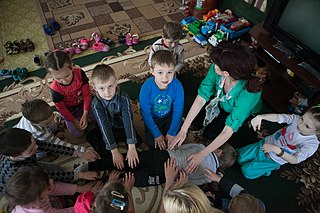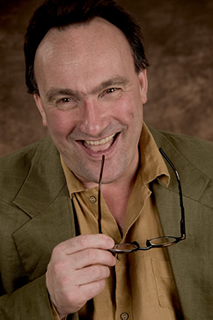Related Research Articles

Psychotherapy is the use of psychological methods, particularly when based on regular personal interaction, to help a person change behavior, increase happiness, and overcome problems. Psychotherapy aims to improve an individual's well-being and mental health, to resolve or mitigate troublesome behaviors, beliefs, compulsions, thoughts, or emotions, and to improve relationships and social skills. Numerous types of psychotherapy have been designed either for individual adults, families, or children and adolescents. Certain types of psychotherapy are considered evidence-based for treating some diagnosed mental disorders; other types have been criticized as pseudoscience.
Group psychotherapy or group therapy is a form of psychotherapy in which one or more therapists treat a small group of clients together as a group. The term can legitimately refer to any form of psychotherapy when delivered in a group format, including art therapy, cognitive behavioral therapy or interpersonal therapy, but it is usually applied to psychodynamic group therapy where the group context and group process is explicitly utilized as a mechanism of change by developing, exploring and examining interpersonal relationships within the group.
Stress management consists of a wide spectrum of techniques and psychotherapies aimed at controlling a person's level of stress, especially chronic stress, usually for the purpose of improving everyday functioning. Stress produces numerous physical and mental symptoms which vary according to each individual's situational factors. These can include a decline in physical health, such as headaches, chest pain, fatigue, and sleep problems, as well as depression. The process of stress management is named as one of the keys to a happy and successful life in modern society. Life often delivers numerous demands that can be difficult to handle, but stress management provides a number of ways to manage anxiety and maintain overall well-being.

Biofeedback is the process of gaining greater awareness of many physiological functions of one's own body by using electronic or other instruments, and with a goal of being able to manipulate the body's systems at will. Humans conduct biofeedback naturally all the time, at varied levels of consciousness and intentionality. Biofeedback and the biofeedback loop can also be thought of as self-regulation. Some of the processes that can be controlled include brainwaves, muscle tone, skin conductance, heart rate and pain perception.
Autosuggestion is a psychological technique related to the placebo effect, developed by pharmacist Émile Coué at the beginning of the 20th century. It is a form of self-induced suggestion in which individuals guide their own thoughts, feelings, or behavior. The technique is often used in self-hypnosis.
Autogenic training is a relaxation technique first published by the German psychiatrist Johannes Heinrich Schultz in 1932. The technique involves repetitions of a set of visualisations accompanied by vocal suggestions that induce a state of relaxation and is based on passive concentration of bodily perceptions like heaviness and warmth of limbs, which are facilitated by self-suggestions. Autogenic training is used to alleviate many stress-induced psychosomatic disorders.

Psychodynamic psychotherapy and psychoanalytic psychotherapy are two categories of psychological therapies. Their main purpose is revealing the unconscious content of a client's psyche in an effort to alleviate psychic tension, which is inner conflict within the mind that was created in a situation of extreme stress or emotional hardship, often in the state of distress. The terms "psychoanalytic psychotherapy" and "psychodynamic psychotherapy" are often used interchangeably, but a distinction can be made in practice: though psychodynamic psychotherapy largely relies on psychoanalytical theory, it employs substantially shorter treatment periods than traditional psychoanalytical therapies.
Self-healing refers to the process of recovery, motivated by and directed by the patient, guided often only by instinct. Such a process encounters mixed fortunes due to its amateur nature, although self-motivation is a major asset. The value of self-healing lies in its ability to be tailored to the unique experience and requirements of the individual. The process can be helped and accelerated with introspection techniques such as Meditation.
A relaxation technique is any method, process, procedure, or activity that helps a person to relax; attain a state of increased calmness; or otherwise reduce levels of pain, anxiety, stress or anger. Relaxation techniques are often employed as one element of a wider stress management program and can decrease muscle tension, lower blood pressure, and slow heart and breath rates, among other health benefits.
Somatic experiencing (SE) is a form of alternative therapy aimed at treating trauma and stress-related disorders, such as PTSD. The primary goal of SE is to modify the trauma-related stress response through bottom-up processing. The client's attention is directed toward internal sensations,, rather than to cognitive or emotional experiences. The method was developed by Peter A. Levine.

Play therapy refers to a range of methods of capitalising on children's natural urge to explore and harnessing it to meet and respond to the developmental and later also their mental health needs. It is also used for forensic or psychological assessment purposes where the individual is too young or too traumatised to give a verbal account of adverse, abusive or potentially criminal circumstances in their life.
Postural Integration is a type of bodywork purporting to draw on "energy" and allow access to the past. It was devised in the late 1960s by Jack Painter (1933–2010) in California, US, after exploration in the fields of humanistic psychology and the human potential movement.
Johannes Heinrich Schultz was a German psychiatrist and an independent psychotherapist. Schultz became world-famous for the development of a system of self-hypnosis called autogenic training.
Common factors theory, a theory guiding some research in clinical psychology and counseling psychology, proposes that different approaches and evidence-based practices in psychotherapy and counseling share common factors that account for much of the effectiveness of a psychological treatment. This is in contrast to the view that the effectiveness of psychotherapy and counseling is best explained by specific or unique factors that are suited to treatment of particular problems.

In psychology, relaxation is the emotional state of low tension, in which there is an absence of arousal, particularly from negative sources such as anger, anxiety, or fear.

Paul Newham is a retired British psychotherapist known for developing techniques used in psychology and psychotherapy that make extensive use of the arts to facilitate and examine two forms of human communication: the interpersonal communication through which people speak aloud and listen to others, and the intrapersonal communication that enables individuals to converse silently with themselves. His methods emphasise the examination of traumatic experiences through literary and vocal mediums of expression, including creative writing, storytelling, and song. He is cited by peers as a pioneer in recognition of his original contribution to the expressive therapies.
José Luis Gonzalez de Rivera y Revuelta, born in Bilbao, Spain, in 1944, was a psychiatrist, pupil of Wolfgang Luthe, and educator in autogenics and anti-mobbing practices.
Eclectic psychotherapy is a form of psychotherapy in which the clinician uses more than one theoretical approach, or multiple sets of techniques, to help with clients' needs. The use of different therapeutic approaches will be based on the effectiveness in resolving the patient's problems, rather than the theory behind each therapy.

Pain psychology is the study of psychological and behavioral processes in chronic pain. Pain psychology involves the implementation of treatments for chronic pain. Pain psychology can also be regarded as a branch of medical psychology, as many conditions associated with chronic pain have significant medical outcomes. Untreated pain or ineffective treatment of pain can result in symptoms of anxiety, depression, and suicidal thoughts, thus it is vital that appropriate pain management occur in a timely fashion following symptom onset.
References
![]() This article incorporates text by José Luis González de Rivera available under the CC BY-SA 3.0 license.Changes include some wording and content ordering.
This article incorporates text by José Luis González de Rivera available under the CC BY-SA 3.0 license.Changes include some wording and content ordering.
- 1 2 Wolfgang Linden; edited by Lehrer PM, Woolfolk RL, Sime WE. "The Autogenic Training Method of JH Schultz." Chapter 7 in Principles and Practice of Stress Management, Third Edition page 152 Guilford Press, 2007 ISBN 9781606238288
- 1 2 3 Stoyva, Johann (June 1986). "Wolfgang: In Memoriam". Biofeedback and Self-Regulation. 11 (2): 91–93. doi:10.1007/BF00999976. S2CID 143439264.
- ↑ Berger N; Devinsky O, Pacia SV, Shachter SC. (eds.) "Autogenic training" Chapter 7 in Complementary and Alternative Therapies for Epilepsy. Demos Medical Publishing, 2005 page 58. ISBN 9781934559086
- 1 2 "Autogenic Therapy." Mosby's Medical Dictionary, 8th edition. (2009)
- 1 2 Gould, D. "It's all in the mind." New Scientist Dec 14, 1978 pages 840-841
- ↑ Dale E. "This Month We Try...Autogenic Training." Health & Fitness Magazine, April 2006
- 1 2 3 4 Suter S. Health Psychophysiology. Psychology Press, 2014. page 169. ISBN 9781317757528
- 1 2 3 4 5 6 7 8 9 10 11 12 13 14 15 16 17 José Luis González de Rivera. "Wolfgang Luthe - Biografia Corta". Instituto de Psicoterapia e Investigación Psicosomática.
- ↑ LA Times. "Dealing With Stress: Cope Or Prevent" LA Times, as carried by Lakeland Ledger, Jun 1, 1989
- 1 2 3 Friis RH, Seaward BH, Dayer-Berenson L. "Managing Stress." Jones & Bartlett Publishers, 2015 page 498 ISBN 9781449688455
- 1 2 Clark CC; editors: Gordon RJ, Harris B, Helvie CO. "Encyclopedia of Complementary Health Practice." Springer Publishing Company, 1999. page 317. ISBN 9780826117229
- 1 2 Alexander J. "Clear away the stress." October 1999 Daily Telegraph
- 1 2 Kenton l. "Hanging Loose" Harpers and Queen Magazine, September 1980
- 1 2 3 4 5 Luthe W; de Rivera L (editor, epilogue, introduction), Selye H. (foreword). "Wolfgang Luthe Introductory Workshop. Introduction to the Methods of Autogenic Training, Therapy and Psychotherapy" (Autogenic Training & Psychotherapy) (Volume 1) January 7, 2015
- 1 2 3 British Autogenic Society. "About Luthe".
- 1 2 Jane Bird. "I Could Do with Some of That!: The Power of Autogenics." Publisher Jane Bird, 2015 ISBN 9781906796983
- ↑ Hainsworth K. "Become Your Own Doctor." The Independent May 3rd 2004
- ↑ Prakash O. (2012) "From Change to Transformation and Beyond: Maintaining Balance on the Fast Track of Life" pages 63–64 2012 ISBN 9781469746586
- ↑ Luthe, W; Schultz, JH. Autogenic Therapy. Vol. 1 Autogenic Methods Vol. 2 Medical Applications Vol. 3 Applications in Psychotherapy Vol. 4 Research and Theory Vol. 5 Dynamics of Autogenic Neutralisation Vol. 6 Treatment with Autogenic Neutralisation. Grune and Stratton, Inc., New York (1969); republished by The British Autogenic Society (2001).
- 1 2 Luthe, W. "About the methods of autogenic therapy." Ancoli S, Peper E, Quinn M (eds.). Mind/Body Integration: Essential Readings in Biofeedback Springer Science & Business Media, 2012 ISBN 9781461328988
- ↑ "Autogenic Neutralisation". British Autogenic Society. 2013.
- ↑ "de Rivera, L; editor Guimón J. "Autogenic psychotherapy and psychoanalysis." The body in Psychotherapy. Karger, Basilea, 1997. pp. 176-181".
{{cite journal}}: Cite journal requires|journal=(help) - ↑ de Rivera, L (2001). "Autogenic Analysis: The Tool that Freud was Looking for". International Journal of Psychotherapy. 6: 71–76.
- ↑ "Creativity Mobilisation Technique". British Autogenic Society. 2013.